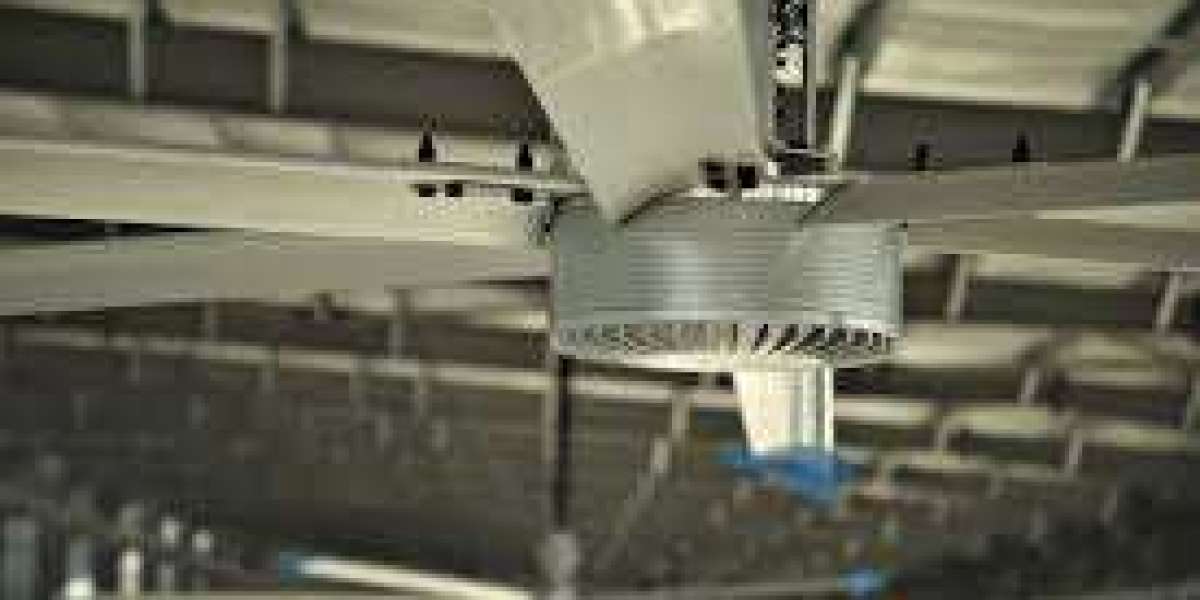Managing airflow and maintaining comfortable conditions in large facilities such as warehouses, factories, gyms, and agricultural buildings can be a constant challenge. Traditional cooling methods like air conditioning or small fans often fall short in these environments, consuming significant amounts of energy without effectively addressing the scale of the space.
Enter HVLS (High-Volume, Low-Speed) industrial fans — an innovative solution designed specifically for large, open spaces. With their massive blades and efficient design, HVLS fans provide superior airflow while dramatically improving energy efficiency. In this article, we’ll explore how HVLS industrial fans work, their benefits, and why they are becoming the go-to choice for large facilities.
What Are HVLS Industrial Fans?
HVLS industrial fans are oversized ceiling fans, typically ranging from 7 to 24 feet in diameter. Unlike small fans that spin rapidly to push limited air, HVLS fans rotate slowly but move massive volumes of air across thousands of square feet.
By creating a gentle, consistent breeze, HVLS fans eliminate stagnant air, regulate temperature, and ensure even airflow throughout large spaces. Their efficiency and effectiveness make them ideal for facilities that struggle with ventilation and high energy costs.
Why Airflow Matters in Large Facilities
Large industrial and commercial spaces pose unique challenges when it comes to ventilation and comfort:
Hot and cold spots: Uneven temperatures due to poor circulation.
Stagnant air: Dust, fumes, and humidity often build up without proper airflow.
High energy costs: Cooling or heating such large areas with traditional systems can be extremely expensive.
HVLS fans address these challenges head-on by circulating massive amounts of air with minimal energy consumption.
1. Boosting Airflow Efficiency
The core strength of HVLS industrial fans lies in their ability to move air more effectively than smaller, high-speed fans.
Large coverage area: A single HVLS fan can cover up to 20,000 square feet, replacing multiple smaller fans.
Consistent airflow: Their design eliminates hot and cold zones, creating a uniform environment across the facility.
Gentle breeze: Unlike high-speed fans that create harsh airflow, HVLS fans generate a comfortable, natural breeze that feels cooling without being disruptive.
This superior airflow ensures workers, equipment, and products all benefit from a healthier and more stable environment.
2. Energy Savings and Cost Efficiency
One of the biggest advantages of HVLS industrial fans is their energy efficiency. By consuming minimal electricity compared to HVAC systems, these fans can significantly reduce energy costs.
Reduced reliance on AC: HVLS fans make indoor spaces feel up to 10°F cooler, lowering the need for air conditioning.
Lower heating costs: In winter, reversing the fan direction pushes warm air from the ceiling down to the floor, a process known as destratification.
Long-term ROI: Facilities often see a 20–30% reduction in energy bills, allowing the fans to pay for themselves over time.
For businesses focused on sustainability and cost control, HVLS fans are a practical and eco-friendly solution.
3. Improved Comfort and Productivity
Employee comfort is directly linked to workplace productivity. Excessive heat, humidity, or poor air quality can cause fatigue, illness, and reduced performance.
HVLS fans create a more pleasant environment by:
Reducing perceived temperatures through increased airflow.
Controlling humidity, preventing condensation and excess moisture.
Improving air quality by dispersing dust and odors.
The result is a safer, more comfortable workplace where employees remain focused and efficient.
4. Protecting Products and Equipment
Airflow isn’t just about comfort — it also plays a vital role in protecting valuable products and equipment.
Preventing spoilage: Perishable goods last longer when stored in well-ventilated environments.
Reducing equipment downtime: Machinery operates more reliably when heat and humidity are controlled.
Avoiding damage: Stable airflow prevents mold, corrosion, or other moisture-related issues.
By ensuring consistent conditions, HVLS fans safeguard inventory and improve the overall reliability of warehouse and factory operations.
5. Versatile Applications
HVLS industrial fans can be installed in a wide range of facilities, including:
Warehouses and distribution centers: For cost-effective cooling and air circulation.
Manufacturing plants: To improve air quality and keep equipment at stable temperatures.
Agricultural barns: To reduce livestock heat stress and control humidity.
Gyms and recreation centers: To provide cooling for athletes and visitors.
Retail spaces: To enhance customer comfort in large shopping areas.
This versatility makes HVLS fans suitable for nearly any large-scale application.
6. Sustainability and Eco-Friendly Operations
As businesses increasingly focus on sustainability, HVLS fans are an excellent way to reduce carbon footprints. By cutting down on the need for energy-intensive HVAC systems, they help businesses meet green initiatives while lowering operational costs. Their durability and long lifespan also mean fewer replacements and less environmental waste over time.
7. Long-Term Reliability and Low Maintenance
Industrial environments demand equipment that can withstand tough conditions. HVLS fans are built with durable materials and powerful motors designed for long-term use. Unlike HVAC systems that require frequent servicing, these fans need minimal maintenance, saving both time and money for facility managers.
Why HVLS Fans Outperform Alternatives
When compared to other ventilation solutions, HVLS fans consistently come out ahead:
Versus HVAC systems: Lower upfront and operating costs, with less energy use.
Versus small fans: Greater coverage, less noise, and lower electricity consumption.
Versus natural ventilation: Reliable airflow regardless of external weather conditions.
Simply put, HVLS fans provide a balance of performance, efficiency, and cost savings unmatched by other cooling methods.
Conclusion
Large facilities face significant challenges in maintaining airflow, comfort, and efficiency. Traditional cooling systems are often too costly or ineffective for such vast spaces. HVLS industrial fans offer the ultimate solution, combining powerful airflow with unmatched energy efficiency.
By lowering energy costs, improving comfort, protecting products, and contributing to sustainable operations, HVLS fans are not just a cooling solution—they’re a strategic investment for the future. For warehouses, factories, gyms, and agricultural facilities alike, HVLS fans stand out as a reliable, long-term choice that enhances both performance and savings.



